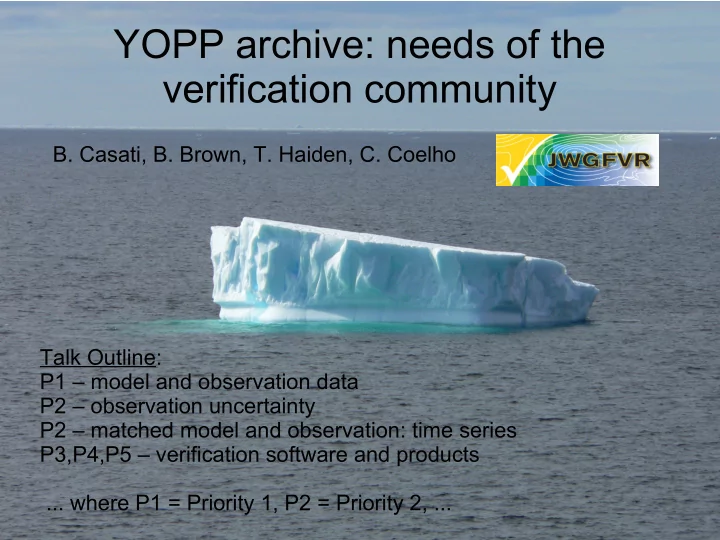

YOPP archive: needs of the verification community B. Casati, B. Brown, T. Haiden, C. Coelho Talk Outline: P1 – model and observation data P2 – observation uncertainty P2 – matched model and observation: time series P3,P4,P5 – verification software and products ... where P1 = Priority 1, P2 = Priority 2, ...
Model and Analyses (P1) ● List of model variables, origin / lead times. ● Grid meta-data (lat lon, topo, land-ocean mask ... ). ● Model data in standard format (GRIB, netcdf). Native grid. ● Code to extract model gridded data (GRIB, netcdf). ● Code to extract data over a subdomain. ● Code to extract model time series at specific location. ➔ This was a shortcoming in TIGGE ● Code to download data includes a selection procedure and a prior estimation of size of data to be downloaded. ● Basic model data display (e.g. maps, Hovmoller diagrams)
Example: ECMWF S2S and TIGGE webAPI interface with Python scripts
Observations (P1) ● Table / landing web-page with obs variables, period coverage, frequency (to be prepared possibly prior obs campaign). ● Observation meta-data (lat-lon, altitude, ... ) ● Gridded obs in standard format (GRIB, netcdf). Native grid. ● Observations at point location in standard format (BURF). YOPP will encompass many different types of obs (gridded, stations, drifting buoys, aircraft measurements, ... ): it will be challenging, but we should aim for as few different formats as possible. ● Code to extract obs time series at specific location. ● Code to extract gridded obs (GRIB, netcdf). ● Code to extract subdomain of data. ● Downloading selection procedure and a prior estimation of size. ● Each dataset basic product display (e.g. time series)
Observation Uncertainty (P2) Observation ● Estimate of the obs uncertainty. ● Observation quality control: ➢ transparent and reproducable procedure (flag); ➢ model-independent; ➢ based on: climatology, spatial coherence, temporal coherence, inter-variable coherence. ● Missing values (retain sample size). Analyses ● Flag / mask to associate level of obs influence / level of background model dependence in analysis; ● Estimate of obs uncertainty from DA algorithms / error var- cov ... (need to outline this with DAOS). Uncertainty in obs is not negligible : there is a growing need to account for observation uncertainty in verification practices!
Example 1: No THIN, TD THIN 2 o , TD RDPS summer 2015, SYNOP vs METAR SYNOP vs METAR TD bias, SYNOP vs METAR without and with thinning (2 o thinning leads to similar sample size and spatial sampling). Example 2: effects of quality control (tipping bucket freeze), FBI. RDPS winter 2015 RDPS winter 2015 CaPA PR6h QC CaPA PR6h noQC QC vs noQC
Verif = Model + Observations (P2) P2: Option to download already matched obs-forecasts (e.g. for time series at point locations): ● Option / code for different interpolations: linear, cubic, spline, Hermite, nearest point, conservative upscaling, ... ● Option / code for temporal matching and aggregation (e.g. 6h and 24h precipitation accumulation). ● Option / code to convert (model-based to observed) variables. P2: Would be nice to archive the model output (at least) with the same frequency of the observations (e.g. for time series at point locations). Note: Polar Regions are characterized by sparse observations. Weather moves: time series / the time dimension can partially compensate for the spatial sparseness.
General software and products (P3) Desiderata (aka P3 and P4): provide script templates for linux/unix/shell environment and (some) codes in (some of) the most popular software (e.g. python, Matlab, R, F90, C++). However we realize that the following list might be ambitious! Alternative: archive could provide links to sites providing software (e.g. NCAR Meteorological Evaluation Toolkit); create a YOPP verification software repository for exchange (outlined by YOPP verification task team). P3 - Basic model and obs data display / manipulation: ● code to read and visualize model and observed gridded data; ● code to read and visualize time series at point locations; ● netcdf-GRIB convertor; ● interpolation and other codes used for obs-forecast matching.
Verification software and products (P4) P3 - Basic verification plots ● P4 - Code to perform basic calculations / verification. ● P4 - Code to aggregate basic statistics (spatially, temporally) ● P4 - Code to perform inference (block bootstrapping) P3 - Option to download basic verification statistics (to be stratified and aggregated by users) P4 – Spatial verification tools. P5 – Multi-variate conditional verification tools: code to extract subset of data based on dynamic condition (target physical process), and perform verification on this sub-sample. Note: P4 codes are all already available in NCAR MET. Ideally: independent YOPP verification web-site similar to TIGGE museum = P1 (but probably not within archive web page).
Conclusions P1 – model, analyses and observation data P2 – observation uncertainty: heavily affects verif results. P2 – matched model and observation: time series P3,P4,P5 – verification software and products ● Several software already exists (NCAR MET). ● Probably will be deferred to an independent YOPP verification webpage similar to the TIGGE museum. THANK YOU!
(Some of the key) YOPP verification challenges Demonstrate added value of: 1. Enhanced observations (in DA, predition, verification); verif in data-sparse regions + obs uncertainty 2. Coupled NWP: heat fluxes, radiation budget (ocean-land- atmosphere exchanges with/without sea-ice, snow). 3. Sea-ice models. YOPP consolidation phase: 4. Pre- versus post-YOPP NWP systems 5. Linkages: improved predictability in Polar Regions leads to improved predictability in mid-latitudes. Need to be further outlined by theYOPP verification task team: B.Casati, T Haiden, H. Goessling, G. Smith, ...
Recommend
More recommend